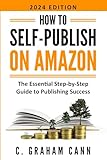It's all About the Cover - Advice for Self-Published Authors
Book cover design is much like every other aspect of writing and publishing: The more you put into it the more you get out of it. Will Kalif discusses the options for cover design available to Print on Demand subsidy published authors.

With the tremendous success of the Print on demand industry there is now a wealth of self published books. An aspiring author can now publish a book at zero cost then purchase copies for himself and his family at steeply discounted prices. This change in self-publishing has brought a veritable revolution in the industry. And it means that there are now tens of thousands of self-published books available to the public.
This new revolution has also brought with it some negative aspects. The biggest of which is the fact that many self-published books are of an inferior quality. Let's face the facts here. Even the best writers need an editor. A book that is going to be sold in the mainstream markets goes through many iterations of writing, editing, rewriting and more editing. Writing, after all, is a very demanding skill. And it takes most writers years to gain some mastery over the craft.
So how does a potential book buyer judge the quality of the writing without actually reading the book? He or she does it by looking at the cover. It makes sense that if the cover is done well the writing will also be done well. This is a judgment call based on perceived effort. How much effort was put into this cover? Is the asked question, and from that assessment we judge how much effort was put into the writing. And even though this isn’t always a good assessment it is what happens. Remember that your potential buyer has a lot of choices and he has to make quick judgments and decisions.
The self-publishing Industry offers you the writer the ability to get an adequate cover for your book by offering a host of easy cover options. All the POD (Print-on-Demand) houses have pre-made cover templates that can easily be adapted or modified for your work. You have seen these templates a hundred times and they are very easy to spot. Just browse though any of the websites that offer these books. Or try the e-book websites. You even see plenty of them on Amazon.com and Barnes & Noble.com, although they almost always don't rank well in sales. Some authors opt to use their own pictures or artwork on the cover and this is a good creative option but how many authors are legitimately trained graphic artists?
Before we get into what you should do let's cover a few things you shouldn’t do:
So what should you do?
First of all, you should spend some time on your cover. Make sure it reflects the writing inside the book. And make sure it is of a superior quality in design and printing. You have spent hundreds of hours laboring over your manuscript. The writing is good and the story is good. Does it make sense to spend an hour or two on cover design and selection? No, it sure doesn't. The cover is another aspect of your work. You should focus a lot of energy on it. I am not saying that you should spend hundreds of hours on it but the general rule applies to covers that applies to everything else. The more you put into it the more you get out of it.
Get some professional help.
Every POD house offers the services of a graphic artist or a team that will design your cover for you. If you can cover the expense and you are serious about marketing your book it would be money well spent. The improvement in quality has the potential to recoup the extra expense many times over. If you can afford it you should look up the services of a professional cover designer.
If you are adamant about keeping creative control over your novel and you want to design the cover yourself here are some rules of thumb. Keep the design simple. In general, the more complex the cover gets the more difficult it is and the less impact it makes on your potential buyer. And when creating the graphics, be sure to very carefully adhere to the publisher’s guidelines for cover art. And always create and save everything in the maximum allowable resolution. Something that looks good on your computer might be blurry or fuzzy when printed onto an actual book.
And finally, you should always get an advance copy of the novel before you give it final approval. You really need to get an actual copy in your hands so you can see and feel the quality of the cover. No matter how good it looks in computerized form it may look totally different in actual print.
Will Kalif is the author of two self-published epic fantasy novels.
You can download free samples of his work at his personal website: Or you can visit his site devoted to fantasy on the web at: Read These NextFocus on Genre: Women’s FictionWomen’s fiction is a literary genre that focuses on female characters and their experiences, relationships, and challenges, and is typically marketed to women. The boundary lines of where this genre starts and begins are murky, however, and the genre itself is not without controversy. Why You Should Run a Goodreads GiveawaySelf-published authors are at a disadvantage when it comes to publicity for their books. A book review in a major newspaper is unlikely, and advertising in trade magazines can be costly. Goodreads can offer a way for authors to reach out directly to readers, making it a great place to spend time promoting your books. Why Publishers Should Be on TwitterWhen I speak to publishers about the benefits of Twitter, I get one of two reactions. They either respond enthusiastically, or they declare that Twitter is a complete waste of time. |







 Self-Publishing For Dummies (For Dummies: Learning Made Easy)
Self-Publishing For Dummies (For Dummies: Learning Made Easy) Self Publishing To Amazon KDP In 2023 - A Beginners Guide To Selling E-books, Audiobooks & Paperbacks On Amazon, Audible & Beyond
Self Publishing To Amazon KDP In 2023 - A Beginners Guide To Selling E-books, Audiobooks & Paperbacks On Amazon, Audible & Beyond How to Self-Publish Your Book: A Complete Guide to Writing, Editing, Marketing & Selling Your Own Book
How to Self-Publish Your Book: A Complete Guide to Writing, Editing, Marketing & Selling Your Own Book Self-Publishing: The Secret Guide To Becoming A Best Seller (Self Publishing Disruption Book 2)
Self-Publishing: The Secret Guide To Becoming A Best Seller (Self Publishing Disruption Book 2) Self Publishing To Amazon KDP In 2024 - A Beginners Guide To Selling E-books, Audiobooks & Paperbacks On Amazon, Audible & Beyond
Self Publishing To Amazon KDP In 2024 - A Beginners Guide To Selling E-books, Audiobooks & Paperbacks On Amazon, Audible & Beyond Write. Publish. Repeat. (The No-Luck-Required Guide to Self-Publishing Success)
Write. Publish. Repeat. (The No-Luck-Required Guide to Self-Publishing Success) How to Self-Publish on Amazon: The Essential Step-by-Step Guide to Publishing Success
How to Self-Publish on Amazon: The Essential Step-by-Step Guide to Publishing Success Self-Publisher's Legal Handbook: Updated Guide to Protecting Your Rights and Wallet
Self-Publisher's Legal Handbook: Updated Guide to Protecting Your Rights and Wallet 14 Steps to Self-Publishing a Book
14 Steps to Self-Publishing a Book How To Self-Publish A Children's Book: Everything You Need To Know To Write, Illustrate, Publish, And Market Your Paperback And Ebook
How To Self-Publish A Children's Book: Everything You Need To Know To Write, Illustrate, Publish, And Market Your Paperback And Ebook